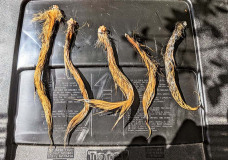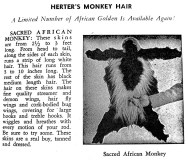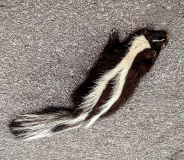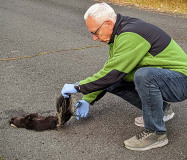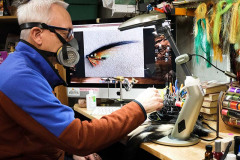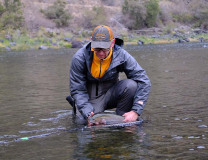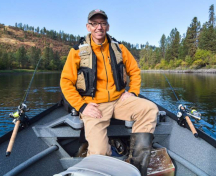No products in the cart.
Not Quite a Sacred Monkey
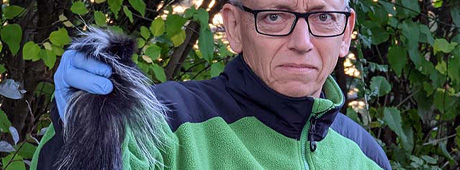
Fly-Tying Gone Rogue
By John O’Bryan
When my wife Kelly found me in the deepest recess of her closet unraveling her best sweater, a feather duster tucked under one of my arms and a fur-lined hat under the other, she was sure I had lost my mind. In a way, she was right.
I used to be a normal person, doing normal person things and going about life like all the other normal people. I went to work, enjoyed weekends with family and friends, and did normal things like washing the car, going on walks and playing with the grandkids.
But when I started tying flies as a hobby, a switch flipped somewhere deep within me and a different version of myself was released. I began looking at life through a new set of lenses, and they weren’t rose-colored.
Kelly is used to it now but when this all started in her closet, she gently took the potential fly-tying material from me and, speaking in quiet, reassuring tones, led me out of the room. She locked the door behind her. It’s been three years and she still won’t let me in unsupervised.
Funnily enough, this fascination with all things feather, fur, and fluffy started on a father-daughter fishing trip I took with a number of other people, who also happened to be fathers and daughters. On the third night of the trip our guide asked if we wanted to tie flies, and since I had done this as a kid, I decided to give it a try.
We tied a wooly bugger with lead-free wire, a chicken feather, a fluffy turkey feather, some yarn-like stuff, a bead for the head, and a piece of colored wire. Reread that list of materials and then imagine catching a fish with what I’ve described. It takes imagination to make something a fish will try to eat out of this list of stuff, and its appeal to the creative side of me was what brought me to the very edge of insanity.
As I was tying this odd conglomeration of material, something began to happen: a beautiful thing emerged and by the time I tied a half-hitch to finish the fly, I was hooked…so to speak. It wasn’t the best fly I would ever tie and it didn’t look much like what our guide had tied but to me it was alien and exotic and beautiful.
Dubious flies. John O'Bryan.
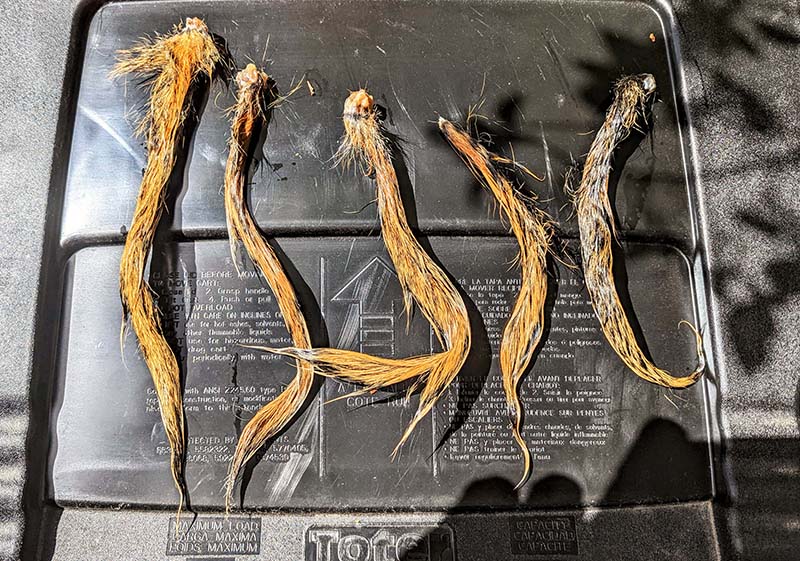
The Sacred Monkey Skin was real. Courtesy John O'Bryan.
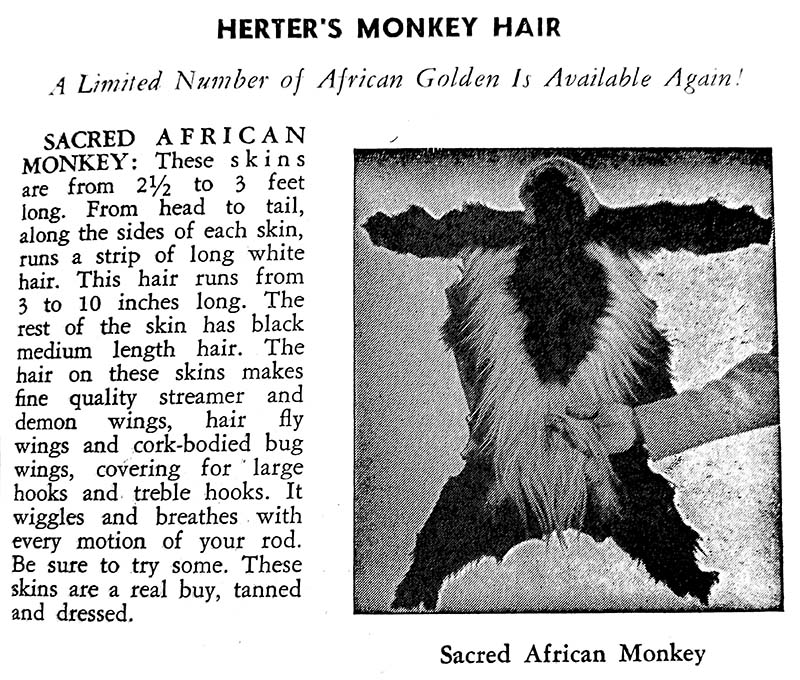
American "sacred monkey" roadkill. John O'Bryan.
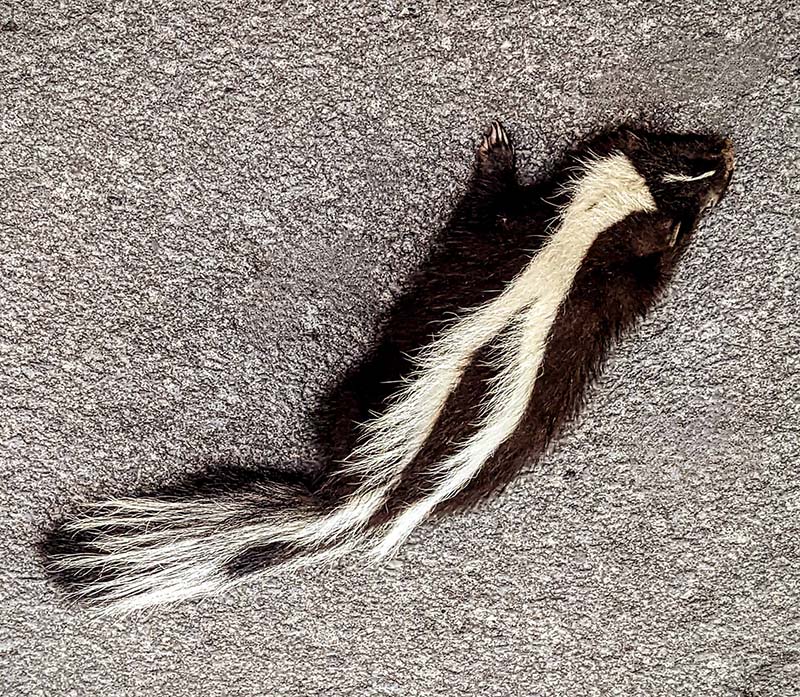
Beware the gland. Kelly O'Bryan.
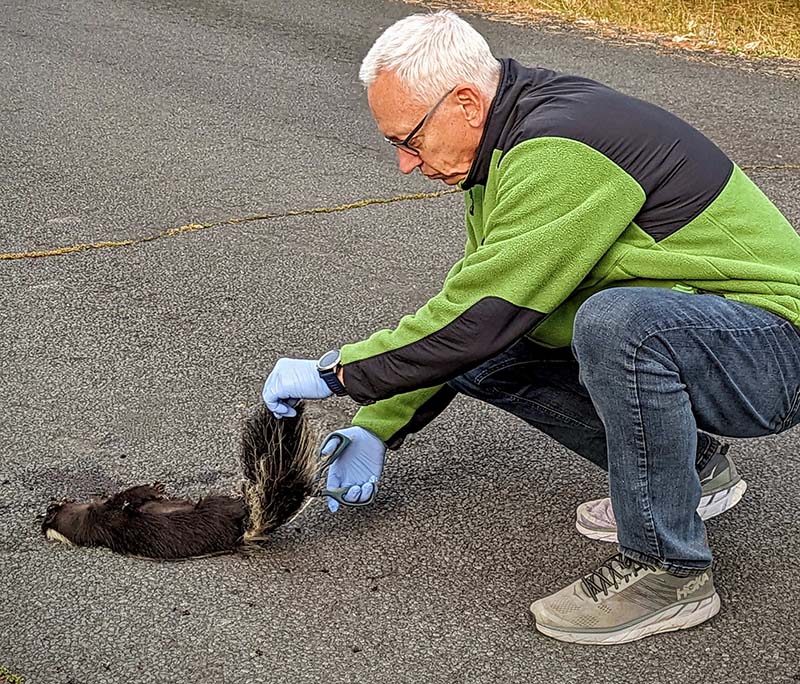
Sharp-shinned hawk. John O'Bryan.
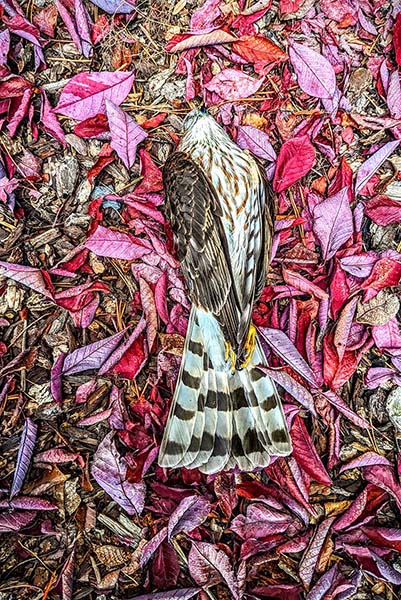
John carefully at work. Kelly O'Bryan.
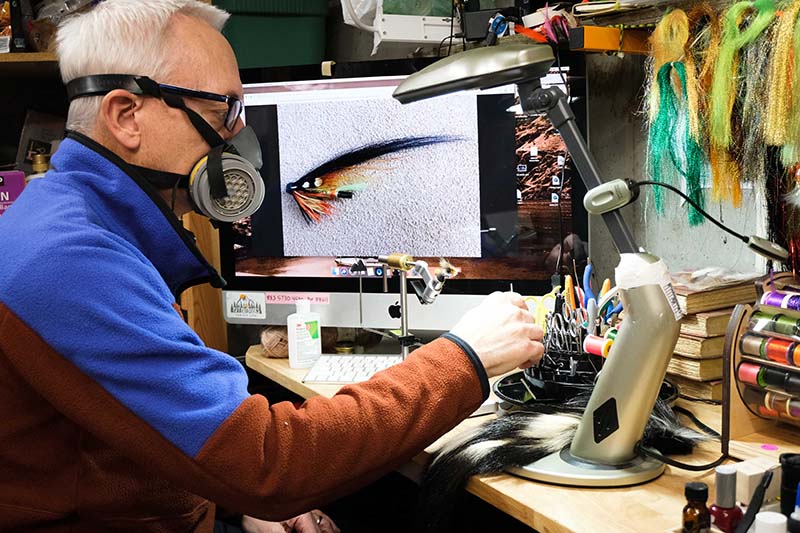
The stinky prize. Kelly O'Bryan.
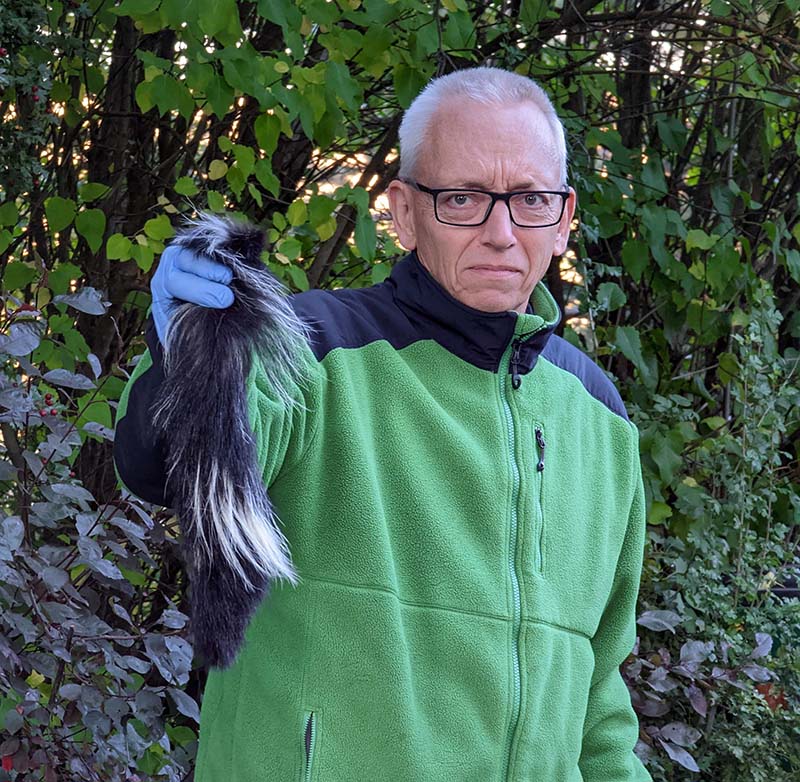
Look at that fish! Jared Harrison.
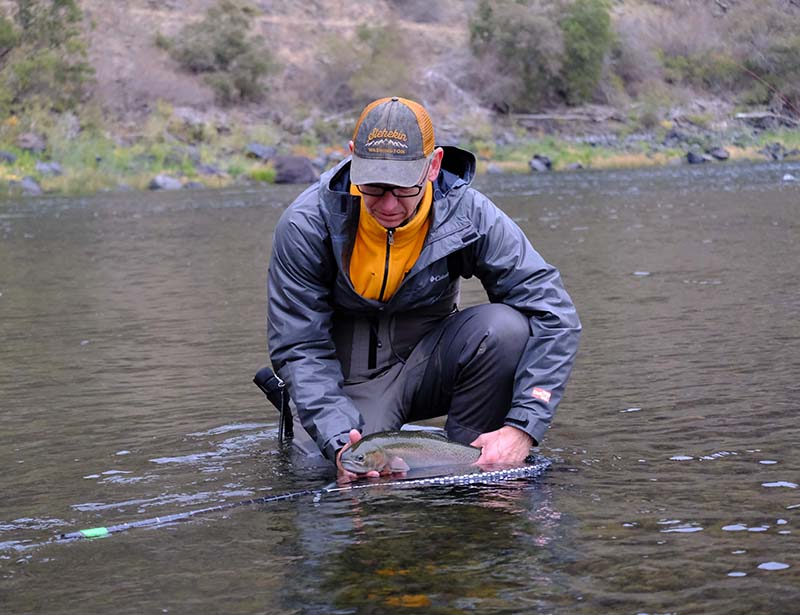
The next week I bought a tying vise from a local guy, which enabled another sort of vice from which I would never quite recover. Kelly says, “All heck broke loose at that moment,” and she’s probably right.
Over the next year I tied flies and did little else. Oh, I still went to work, hung out with friends, did yard work, fixed things around the house, but I did it all while dreaming of tying. I bought and traded for countless piles of tying material and tools and books. I bought hooks and tools and vises and UV gel and fingernail polish and jewelry-making supplies and scissors and every other conceivable thing that might help me make better flies.
My friends grew sick of me talking about my newest creation or the thing I had just purchased, so I kept it all to myself, but as I lay in bed at night trying to sleep, instead of counting sheep I tied flies in my head.
I also shared this passion with anyone who wanted to learn. I taught moms and dads and kids and anyone else who wanted to figure out how to tie feather to hook. I even created my own YouTube channel and got a small following. The pandemic was the heyday for this since people had so much in-house time and were looking for things to do.
But YouTube killed my desire to do what I loved since all I did was think about which fly would get people to watch me and then maybe I would make money from it.
I justified my obsession as being necessary and good. I think that’s what people who have an addiction do but my situation had to be different because I was sharing it with others and not just hiding in my basement. My kids say my entire life I had been preparing for the pandemic, because I might have hoarding issues, and I definitely have germ issues. My job is in procurement at a local hospital where we probably have more personal protective equipment than any other hospital in the state.
Kelly calls me a hoarder and maybe she’s right but I’m not a classic hoarder. We can still walk through our house without bumping into things. We have no cats. Our house is spotless and most of my stuff is hidden away or neatly arranged on the shelves in my tying room, although there is a lot of it. It’s not a sickness in the strictest sense—I think I just look at things differently than others do, which is to say everything seems like it would look good tied to a hook.
So I find a place for it in my tying room. Most of it I never use, but it’s there in case some day I do need a pile of lint from the dryer to make a lint fly. It’s actually more about collecting than hoarding, and all those people who think I have enough fly-tying material have no idea what they’re talking about. How is that even possible?
Every new fly recipe I try requires some odd material that I don’t have. I get it online when possible but there are just some things that are no longer sold anywhere. In the 1950s, the mail-order outdoor goods catalogue Herter’s sold Sacred African Monkey Skins (SAMS). I am amazed and saddened by what people killed and sold in the name of fly-tying and it makes me sick to think about all the animals that died so their skins could be sold for three dollars.
Thankfully, killing exotic animals for resale has become illegal, and because of this I couldn’t find a single sacred monkey skin anywhere on the internet. Ethical fly-tyers have had to find alternatives for the exotic stuff, so I began searching for a suitable alternative that would work for the SAMS fly that I had been told steelhead can’t resist.
This led me to a fork in the road and instead of turning left I turned right down a rabbit trail that I never should have followed. I am a bit ashamed to say this but I’ve turned to something nefarious yet perfectly legal for exotic tying material: roadkill.
Don’t judge me. Idaho is one of twenty states in the union that allow legal harvesting of roadkill. If the animal is found right away it can be cut up and put in someone’s freezer or given to the local food bank. Most people don’t harvest smaller animals such as rabbits, squirrels, or even deer, but it’s not unusual to see a group of people with knives in hand surrounding a freshly dead elk or moose.
There must be a network of people who call each other when a large animal is found because the same group of people are on these animals faster than blowflies. It may seem a bit odd that the food bank is handing out roadkill to locals in need but don’t recoil if you haven’t eaten a nicely cooked elk steak.
I’ve eaten elk and moose, and it is very, very good. Some say it’s way (or should I say wagyu), better than that high-priced beef from Japan.
I’ve never field-dressed an animal bigger than a goose and I wouldn’t know a backstrap from a tenderloin if someone slapped me in the face with it. You will also never find me huddled around a dead animal in the middle of the night with a knife in hand. However, when I spot a dead animal on the road I slow down to see if there’s anything I might want, and by “anything” I mean pieces of fur or feather that might make really cool fishing flies.
I know some of you are screaming at me in your head right now that it’s illegal to pick up dead birds and even to pick up feathers from dead birds. I am aware of this, and while it would be tempting to salvage exotic bird material from the National Wildlife Property Repository (look it up) I would never do it and I have memorized most parts of the 1918 Migratory Bird Treaty Act, so I never pick up anything illegal. But I do stop, just in case.
The Migratory Bird Treaty Act was created because around the turn of the century millions and millions of birds were killed to create women’s hats. Large categories of exotic birds were brought to the edge of extinction because women were dying to get, or at least willing to kill, for these hats. The treaty made it illegal to even pick up feathers from native migratory birds.
This law is still in place today, though I don’t think anyone has ever been prosecuted for picking up a pretty feather but it’s still a possibility. However, if you ever see a dead raptor, especially a bald eagle, leave it be. You very well could get in trouble for owning those feathers.
The problem is that there are just so many potentially amazing fly-tying materials lying dead on the road that I feel I have to stop. Plus it’s all free and I really like free. What if the next animal I see lying on the side of the road has fur textured perfectly to mimic sacred monkey skin? As it turned out, this was exactly what happened, and it changed my life forever.
By now, I think it’s clear that my obsession with trying to find the perfect fur or feather to make the perfect fly forces me to walk a fine line between what is perceived as normal and what is just plain weird. I crossed that line recently, and I’m still not sure how I feel about it.
Kelly has gotten used to me stopping for dead things but on this day as I slowed down, she moved her foot onto the gas pedal and pressed hard.
“What are you doing?” I screamed as the car rushed by the carcass.
“You can’t be serious about stopping for that thing,” she said.
I turned the key to kill the engine, being careful not to lock the steering wheel, looked over at her, and smiled my most innocent smile as we rolled to a stop some thirty yards past the animal.
“I am serious.”
I removed the keys and pocketed them as I got out, because on more than one occasion I have walked home with my free material, and I wasn’t taking any chances.
“It’s a tiny sacred monkey!” I screamed over my shoulder as I ran back to the animal.
When I knelt beside my newfound treasure, I immediately realized what a huge miscalculation I had made. I heard the truck door slam and watched through tears as Kelly stopped fifteen yards away and pointed her phone at me. I knew she intended to share this later with her friends over a glass of wine.
I held my breath and quickly snipped the sacred monkey tail but in my haste I accidentally sliced down the middle of the scent gland. Glandular stink juice shot all over my hands and arms. I stumbled to my feet and ran blindly but the smell followed me like a green specter. In my blinded state I fell headfirst into a ditch. I lay there dry-heaving, a black-and-white tail in one hand and a soiled pair of scissors in the other.
I heard Kelly walk up and knew by her silence that she once again was questioning her decision to marry me. She fished the keys out of my pocket.
“You’re riding in the back of the truck,” she said in an even, measured voice. At least that’s what it sounded like. It was hard to tell with her face pressed into her elbow. “Now get in.”
I rolled into the truck’s bed and lifted myself to a seated position. As I leaned against the cab, tears rolling down my face, my chest heaving and one hand dangling the tail of the skunk over the edge of the truck bed, I wondered if this was nothing more than a subconscious cry for help.
Maybe deep down I wanted someone to step in and stop me. I pondered this for a moment, and then looked at the sacred monkey tail hanging outside the truck and imagined all the cool flies I was going to tie with it.
“Nah, I don’t need help,” I thought, and threw up.
Kelly parked far away from the house and made me stay where I was until she could escape my aura. She told me in no uncertain terms to strip at the back of the house and to throw the tail, which she called “that thing” to the end of the property.
As I stood shivering, a painful rain of brushes, baking powder and dish soap fell from the sky. Kelly has a great arm and is a good shot. Welts arose on parts of my body that hadn’t seen daylight in years.
I turned on the hose and let it soak over my head and body. I shivered as I washed and scrubbed and cleaned and bathed until I felt like I was relatively presentable. Feebly, I knocked at the back door. My wife appeared in the sliding glass window and used hand signs that directed me to close my eyes and turn around.
This did not make me feel entirely comfortable but I did it and waited. I heard the sliding door open and a cold spray enveloped me. She was coating me with the spray kept in the bathroom for when my Uncle Lyman came to visit.
“Turn in a circle!”
It wasn’t a request, and I obeyed. Every inch of me that I could not cover with my hands was coated in aerosol. “Stand there and dry off.” I obeyed again.
She threw clothes at me and after I dried, I put them on. She returned an hour later, opened the door a crack, and sniffed me. She slid the door all the way open and I was allowed into the basement. It took a few days for her to let me into the rest of the house.
Later that week I gloved and masked and surreptitiously visited my sacred monkey tail. Kelly didn’t need to know I had kept it. I bagged it and filled the bag with water, soap, and all the stuff my wife had sprayed me with. I washed and rinsed and rinsed and washed until the water ran clear.
I removed my mask and did the sniff test. It wasn’t perfect but it was good enough. I could definitely use this fur…when Kelly was out of the house.
A few weeks later she left for the evening and I ran to the basement to tie the sacred monkey skin steelhead fly. As I quickly clipped and tied the hair to the hook, it struck me that I was one of only a handful of men who had walked into the abyss, harvested their own black-and-white stinky sacred monkey tail and lived to tell about it. I felt a moment of intense pride.
You might think, was all the pain and suffering and indignation from my wife worth it? You tell me…I mean, just look at that fish!
This story originally appeared in an altered form on the AvidMax blog.
This content is available for purchase. Please select from available options.
Purchase Only
Purchase Only

